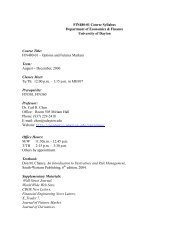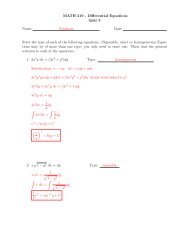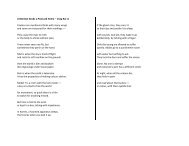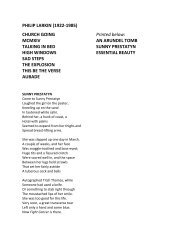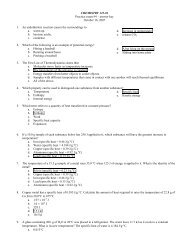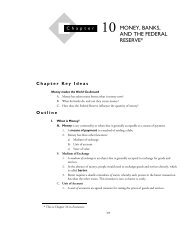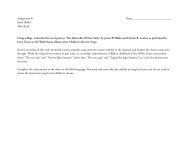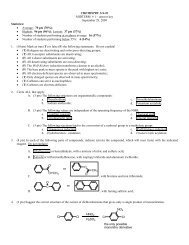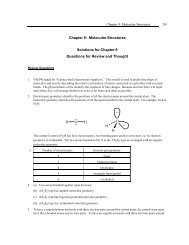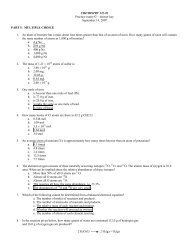answers
answers
answers
You also want an ePaper? Increase the reach of your titles
YUMPU automatically turns print PDFs into web optimized ePapers that Google loves.
Name:___________________________<br />
PSY 216<br />
Assignment 13<br />
1. In a repeated-measures ANOVA, the denominator of the F-ratio is called the _residual<br />
variance__________________________________________, or the __error<br />
variance____________________________________________, and measures how much variance is expected if there<br />
are no systematic treatment effects and no individual differences contributing to the variability of the<br />
scores.<br />
2. Problem 6 from the text<br />
A published report of a repeated-measures research study includes the following description of the statistical analysis. “The<br />
results show significant differences among the treatment conditions, F(2, 20) = 6.10, p < .01.”<br />
a. How many treatment conditions were compared in the study?<br />
dfbetween-treatments = k - 1<br />
k = dfbetween-treatments + 1<br />
k = 2 + 1 = 3<br />
b. How many individuals participated in the study?<br />
dfwithin-treatment = dfbetween subjects + dferror<br />
k * (n – 1) = (n – 1) + 20<br />
3 * (n – 1) = (n – 1) + 20<br />
2 * (n – 1) = 20<br />
2n – 2 = 20<br />
2n = 22<br />
n = 11<br />
3. Enter the data from problem 9 into SPSS. Use SPSS to answer the following question: Do the data<br />
indicate significant mean differences among the three treatments? Give H0, H1 and α. Is this a onetailed<br />
or two-tailed test? Use SPSS to compute η 2 . Write a sentence or two in APA format that<br />
summarizes the results of the analysis.<br />
The following data were obtained from a repeated-measures study comparing three treatment conditions.<br />
Person I<br />
Treatments<br />
II II Person Totals<br />
A<br />
1<br />
1<br />
4<br />
P = 6<br />
B<br />
3<br />
4<br />
8<br />
P = 15<br />
C<br />
0<br />
2<br />
7<br />
P = 9<br />
D<br />
0<br />
0<br />
6<br />
P = 6<br />
E<br />
1<br />
3<br />
5<br />
P = 9<br />
M = 1<br />
M = 2<br />
M = 6<br />
T = 5<br />
T = 10<br />
T = 30<br />
N = 15<br />
G = 45<br />
ΣX 2 = 231
Step 1:<br />
H0: μ1 = μ2 = μ3<br />
H1: not H0<br />
α = .05<br />
Two-tailed<br />
Step 3:|<br />
SS = 6 SS = 10 SS = 10<br />
Descriptive Statistics<br />
Mean Std. Deviation N<br />
Treatment 1 1.0000 1.22474 5<br />
Treatment 2 2.0000 1.58114 5<br />
Treatment 3 6.0000 1.58114 5<br />
Measure:MEASURE_1<br />
Source<br />
Tests of Within-Subjects Effects<br />
Type III Sum<br />
of Squares df<br />
Mean<br />
Square F Sig.<br />
Partial Eta<br />
Squared<br />
treatment Sphericity Assumed 70.000 2 35.000 35.000 .000 .897<br />
Greenhouse-Geisser 70.000 1.600 43.750 35.000 .000 .897<br />
Huynh-Feldt 70.000 2.000 35.000 35.000 .000 .897<br />
Lower-bound 70.000 1.000 70.000 35.000 .004 .897<br />
Error(treatment) Sphericity Assumed 8.000 8 1.000<br />
HSD = 4.04 * √(1 / 5) = 1.81<br />
H0: μTx1 = μTx2<br />
H1: μTx1 ≠ μTx2<br />
Greenhouse-Geisser 8.000 6.400 1.250<br />
Huynh-Feldt 8.000 8.000 1.000<br />
Lower-bound 8.000 4.000 2.000<br />
Tx1 - Tx2 = 1 – 2 = -1 ☞ Fail to reject H0<br />
H0: μTx1 = μTx3<br />
H1: μTx1 ≠ μTx3<br />
Tx1 - Tx3 = 1 – 6 = -5 ☞ Reject H0
H0: μTx2 = μTx3<br />
H1: μTx2 ≠ μTx3<br />
Tx2 - Tx3 = 2 – 6 = -4 ☞ Reject H0<br />
Table 1 shows the mean and standard deviation for each treatment. The repeated measures analysis of<br />
variance revealed a significant effect of treatment on the dependent variable, F(2, 8) = 35.00, p = .000,<br />
MSerror= 1.00, η 2 = .897. Tukey HSD tests revealed that Treatment 3 was reliably different from Treatments 1 and 2,<br />
but that there is insufficient evidence to suggest that Treatments 1 and 2 are reliably different from each other.<br />
Table 1<br />
Means and Standard Deviations for Each Treatment<br />
---------------------------------------------------------------------------------------<br />
Treatment M SD<br />
1 1 1.22<br />
2 2 1.58<br />
3 6 1.58<br />
---------------------------------------------------------------------------------------<br />
4. Enter the data from problem 11 into SPSS. Use SPSS to answer the following question: Do the<br />
data indicate significant mean differences among the three treatments? Give H0, H1 and α. Is this a<br />
one-tailed or two-tailed test? Use SPSS to compute η 2 . Write a sentence or two in APA format that<br />
summarizes the results of the analysis.<br />
Step 1:<br />
H0: μ1 = μ2 = μ3<br />
H1: not H0<br />
α = .05<br />
Two-tailed<br />
Descriptive Statistics<br />
Mean Std. Deviation N<br />
Treatment 1 3.0000 2.94392 4<br />
Treatment 2 4.0000 3.16228 4<br />
Treatment 3 5.0000 3.55903 4<br />
Tests of Within-Subjects Effects
Measure:MEASURE_1<br />
Source<br />
Type III Sum<br />
of Squares df<br />
Mean<br />
Square F Sig.<br />
Partial Eta<br />
Squared<br />
Treatment Sphericity Assumed 8.000 2 4.000 6.000 .037 .667<br />
Greenhouse-Geisser 8.000 1.000 8.000 6.000 .092 .667<br />
Huynh-Feldt 8.000 1.000 8.000 6.000 .092 .667<br />
Lower-bound 8.000 1.000 8.000 6.000 .092 .667<br />
Error(Treatment) Sphericity Assumed 4.000 6 .667<br />
HSD = 4.34 * √(0.667 / 4) = 1.77<br />
H0: μTx1 = μTx2<br />
H1: μTx1 ≠ μTx2<br />
Greenhouse-Geisser 4.000 3.000 1.333<br />
Huynh-Feldt 4.000 3.000 1.333<br />
Lower-bound 4.000 3.000 1.333<br />
Tx1 - Tx2 = 3 – 4 = -1 ☞ Fail to reject H0<br />
H0: μTx1 = μTx3<br />
H1: μTx1 ≠ μTx3<br />
Tx1 - Tx3 = 3 – 5 = -2 ☞ Reject H0<br />
H0: μTx2 = μTx3<br />
H1: μTx2 ≠ μTx3<br />
Tx2 - Tx3 = 4 – 5 = -1 ☞ Fail to reject H0<br />
Table 1 shows the mean and standard deviation for each treatment. The repeated measures analysis of<br />
variance revealed a significant effect of treatment on the dependent variable, F(2, 6) = 6.00, p = .037,<br />
MSerror= 0.67, η 2 = .667. Tukey HSD tests revealed that Treatment 1 was reliably different from Treatment 3, but<br />
that there is insufficient evidence to suggest that Treatments 1 and 2 are reliably different from each other or that<br />
Treatments 2 and 3 are reliably different from each other.<br />
Table 1<br />
Means and Standard Deviations for Each Treatment<br />
---------------------------------------------------------------------------------------
Treatment M SD<br />
1 3 2.94<br />
2 4 3.16<br />
3 5 3.56<br />
---------------------------------------------------------------------------------------<br />
5. Problem 16 from the text<br />
The following summary table presents the results from a repeated-measures ANOVA comparing three treatment conditions, each<br />
with a sample of n = 11 participants. Fill in the missing values in the table. (Hint: Start with the df values).<br />
Source SS df MS<br />
Between treatments<br />
Within treatments<br />
Total<br />
Between subjects<br />
Error<br />
_30 = 2 * 15_<br />
80<br />
_20 = 80 - 60_<br />
60<br />
_110 = 30 + 80_<br />
_2 = 3 - 1_<br />
_30 = 32 - 2_<br />
_10 = 11 - 1_<br />
_20 = 30 - 10_<br />
_32 = 3 * 11 - 1_<br />
dfBetween treatments = # of levels of the IV – 1 = 3 – 1 = 2<br />
_15 = 3 * 5_<br />
_3 = 60 / 20_<br />
F = 5.00<br />
dfTotal = # of observations – 1 = # of levels of the IV * # of people per condition – 1 = 3 * 11 – 1 = 32<br />
dfWithin treatments = dfTotal – dfBetween treatments = 32 – 2 = 30<br />
dfBetween subjects = # of participants – 1 = 11 – 1 = 10<br />
dfError = dfWithin treatments – dfBetween subjects = 30 – 10 = 20<br />
MSError = SSError / dfError = 60 / 20 = 3<br />
MSBetween treatments = FBetween treatments * MSError = 5 * 3 = 15<br />
SSBetween treatments = dfBetween treatments * MSBetween treatments = 2 * 15 = 30<br />
SSBetween subjects = SSWithin treatments – SSError = 80 – 60 = 20<br />
SSTotal = SSBetween treatments + SSWithin treatments = 30 + 80 = 110




